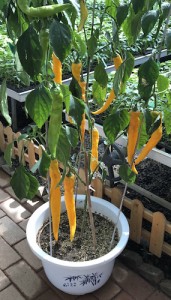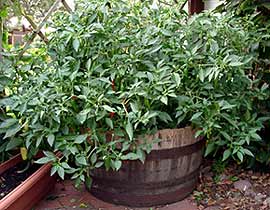 I just got back from the Zunyi Capsicum Expo in southwestern China. At the two-acre greenhouse at Bozhou International Chili Industry Park, the entrance displays shown above are the three chilli sculptures made with chillis. Each of these was constructed with more than 40,000 individual pods. But these were not the main attraction of the greenhouse. The giant chilli plants were the mind-boggling, eye-opening botanical charms. These plants are six to eight feet tall and are supported by very thin wires strung from the top roof. Two questions come to mind: how did the horticulturists accomplish this, and why? In China, the citizens strive to live up to “the bigger the better” syndrome, so the tall chilli plants fit right into that philosophy. That’s the why, but the how is what I want to know. It must have to do with phototropism and manipulating the light in the greenhouse and the fact that chillis are perennials. All plants grow toward the sun or lights. If the light is restricted, the plants grow larger leaves to capture more of it for photosynthesis and also grow taller and will flop over if not supported. So I think plants like these have been growing for years, supported by the wires you can see if you look at the thatched umbrella at the upper left of the photo.
I just got back from the Zunyi Capsicum Expo in southwestern China. At the two-acre greenhouse at Bozhou International Chili Industry Park, the entrance displays shown above are the three chilli sculptures made with chillis. Each of these was constructed with more than 40,000 individual pods. But these were not the main attraction of the greenhouse. The giant chilli plants were the mind-boggling, eye-opening botanical charms. These plants are six to eight feet tall and are supported by very thin wires strung from the top roof. Two questions come to mind: how did the horticulturists accomplish this, and why? In China, the citizens strive to live up to “the bigger the better” syndrome, so the tall chilli plants fit right into that philosophy. That’s the why, but the how is what I want to know. It must have to do with phototropism and manipulating the light in the greenhouse and the fact that chillis are perennials. All plants grow toward the sun or lights. If the light is restricted, the plants grow larger leaves to capture more of it for photosynthesis and also grow taller and will flop over if not supported. So I think plants like these have been growing for years, supported by the wires you can see if you look at the thatched umbrella at the upper left of the photo.
 The container plants in the greenhouse reveal their large leaves. The fruits also seem to be inordinately large, so that too is part of the mystery. Our guide admitted that the plants were manipulated but would not tell us how. My problem with all this is that it gives the visitor the idea that they can grow chillis like this in their garden, when of course they cannot. This is an exaggerated display that is not true to life. But it certainly is spectacular, which in China can be the main point of many exhibits.
The container plants in the greenhouse reveal their large leaves. The fruits also seem to be inordinately large, so that too is part of the mystery. Our guide admitted that the plants were manipulated but would not tell us how. My problem with all this is that it gives the visitor the idea that they can grow chillis like this in their garden, when of course they cannot. This is an exaggerated display that is not true to life. But it certainly is spectacular, which in China can be the main point of many exhibits.
Follow Up Note
My good friend and coauthor, Dr. Paul Bosland, says that the greenhouse is not mysterious at all. “If you’re wondering about the height of the chiles, this is normal in greenhouse operations. Even the colored bells and tomatoes are bred to be “viney” to grow upwards. It is to maximize the use of the space. The plants can keep growing upward to produce more fruit. In open field production, one wants compact plants. The sprawling plants, like those for greenhouse production, are problematic for open-field production. My guess on the ‘secret sauce’ is that they may be using a plant growth hormone like GA to encourage the plants to continue to grow upwards.”











